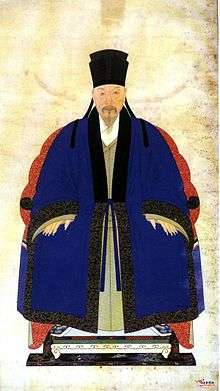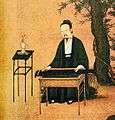Beizi

A beizi (褙子) is an item of traditional Chinese attire common to both men and women, a large loose coat. It was most popular during the Song Dynasty and Ming Dynasty. The origin date of beizi is unknown, and someone believed that beizi and banbi had been adopted from Central Asia during the Tang Dynasty through the Silk Road when cultural exchanges were frequent.[1][2] However, it is also believed to have been derived from banbi during the Song Dynasty, where the sleeves and the garment lengthened.[3]
The gender difference is that while wide-sleeved beizi were considered formal wear for women (narrow-sleeved beizi were casual wear for women), both wide and narrow-sleeved beizi were only used as casual wear for men. It has a parallel/straight-collar (對襟) with side slits beginning at the armpit or at the waist. It can be secured at the front either with ties or a metal button.
-

Court Ladies of the Former Shu wearing post-Tang Style beizi.
-

A man wearing a "Song Styled" beizi.
-

Ming Dynasty portrait of a Woman wearing a "Ming Styled" beizi.
-

Ming Dynasty portrait of a man wearing a "Ming Styled" beizi.
-

A Ming Portrait of a man wearing "Ming styled" Beizi
See also
References
- ↑ Yoon, Ji-Won. Research of the Foreign Dancing Costumes: From Han to Sui-Tang Dynasty, The Korean Society of Costume, v. 56, 57-72. 2006
- ↑ Kim, Sohyun. A Study on the Costume of Khotan, The Korean Society of Costume, v. 34, 169-183. 1997.
- ↑ 朱和平 (July 2001). 《中国服饰史稿》 (PDF) (in Chinese) (1st ed.). 中州古籍出版社: 223–224. Retrieved May 20, 2009.